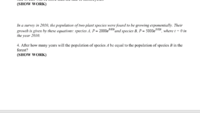rachelmaddie
Full Member
- Joined
- Aug 30, 2019
- Messages
- 851
i need my work checked please.
4.
We need to see when the equations for the population of each species are equal so equate them and solve for t.
2000e^(0.05t) = 5000e^(0.02t)
(⅖)e^(0.05t) = e^(0.02t) Divide each side by 5000.
⅖ = e^(0.02t) / e^(0.05t) Divide each side by e^(0.05t)
⅖ = e^(-0.03t) Use e^a / e^b = e^(a- b)
In(⅖) / -0.03 Divide each side by -0.03
—> = 30.54
Therefore, the population of Species A will be equal to the population of Species B after 30.54 years.

4.
We need to see when the equations for the population of each species are equal so equate them and solve for t.
2000e^(0.05t) = 5000e^(0.02t)
(⅖)e^(0.05t) = e^(0.02t) Divide each side by 5000.
⅖ = e^(0.02t) / e^(0.05t) Divide each side by e^(0.05t)
⅖ = e^(-0.03t) Use e^a / e^b = e^(a- b)
In(⅖) / -0.03 Divide each side by -0.03
—> = 30.54
Therefore, the population of Species A will be equal to the population of Species B after 30.54 years.
